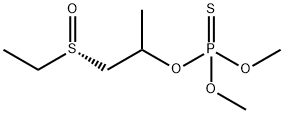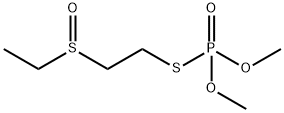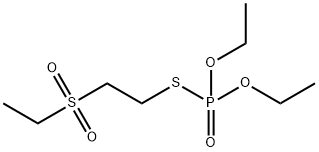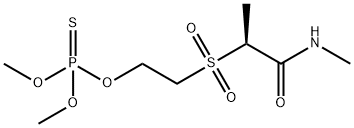DEMETON-S-METHYL
Synonym(s):S-[2-(Ethylthio)ethyl] O,O-dimethyl phosphorothioate;Methyldemetone;S-(2-Ethylthioethyl) O,O-dimethyl phosphorothioate
- CAS NO.:919-86-8
- Empirical Formula: C6H15O3PS2
- Molecular Weight: 230.29
- MDL number: MFCD00055464
- EINECS: 213-052-6
- SAFETY DATA SHEET (SDS)
- Update Date: 2023-05-25 10:25:51

What is DEMETON-S-METHYL?
Description
Demeton-S-methyl is pale yellow in colour and oily and has a sulphur-like odour. It is sparingly soluble in water but very rapidly soluble in common polar organic solvents such as dichloromethane, 2-propanol, toluene, and n-hexane. It is a highly toxic, systemic, and contact insecticide and acaricide and classified as Category I. It is used for the control of insects, aphids, sawflies, and spider mites on cereals, fruits, vegetables, and ornamental plants. On heating, demeton-S-methyl undergoes decomposition and emits very toxic fumes, phosphorus oxides, and sulphur oxides.
Chemical properties
Demeton-S-methyl is pale yellow in color, oily and has a sulfur-like odor. It is sparingly soluble in water, but is very rapidly soluble in common polar organic solvents, such as dichloromethane, 2-propanol, toluene, and n-hexane. It is a highly toxic, systemic, and contact insecticide and acaricide and is classifi ed as Category I. It is used for the control of insects, aphids, saw-fl ies, and spider mites on cereals, fruits, vegetables, and ornamental plants. On heating, demeton-s-methyl undergoes decomposition and emits very toxic fumes, phosphorus oxides, and sulfur oxides.
Chemical properties
Demeton-methyl is a colorless to pale yellow oily liquid. Unpleasant odor. It is a mixture of Demeton-S and Demeton-O and may be formulated in a flammable organic solvent that may alter the physical properties shown here.
Chemical properties
Demeton is a light brown liquid with an odor of sulfur compounds; freezing/melting point ≤‐13 C
The Uses of DEMETON-S-METHYL
Demeton-S-methyl is a systemic insecticide used to control sucking insects and mites in a wide range of crops and ornamentals.
The Uses of DEMETON-S-METHYL
Colinesterase inhibitor. Used as insecticide.
The Uses of DEMETON-S-METHYL
Insecticide.
Definition
ChEBI: Demeton-S-methyl is an organic thiophosphate and an organothiophosphate insecticide. It has a role as an acaricide, an agrochemical and an EC 3.1.1.7 (acetylcholinesterase) inhibitor. It is functionally related to a 2-(ethylsulfanyl)ethanethiol.
General Description
Pale yellow oil. Used as an insecticide. Not registered as a pesticide in the U.S.
Reactivity Profile
Organophosphates, such as DEMETON-S-METHYL, are susceptible to formation of highly toxic and flammable phosphine gas in the presence of strong reducing agents such as hydrides. Partial oxidation by oxidizing agents may result in the release of toxic phosphorus oxides.
Health Hazard
DEMETON-S-METHYL inhibits the nervous system and is absorbed readily through the skin. DEMETON-S-METHYL is a liquid organophosphorus insecticide. Poisonous; may be fatal if inhaled, swallowed or absorbed through skin. Contact may cause burns to skin and eyes.
Health Hazard
Demeton-S-methyl is highly toxic to animals and humans. Careless occupational exposures to demeton-S-methyl cause severe symptoms of poisoning that include, but are not limited to, headaches, nausea, vomiting, diarrhea, sweating, dizziness, tremors, lack of coordination, hiccough, and memory loss. Prolonged exposures to high concentrations cause pupillary constriction, blurred vision, muscle cramp, excessive salivation, weakness, sweating, abdominal cramps, unconsciousness, respiratory distress, convulsions, respiratory failure, and death.
Health Hazard
Highly toxic by all routes of exposure;cholinesterase inhibitor; toxic symptoms similar to those of Demeton and range formheadache, dizziness, blurred vision, and muscle spasms to gastrointestinal effects manifesting vomiting, diarrhea, and abdominalpain, as well as respiratory symptoms ofdyspnea, respiratory depression, and paral-ysis; high exposures may result in onset ofseizures and loss of consciousness; absorbedreadily through skin.
LD50 oral (rat): 30–60 mg/kg
LD50 oral (guinea pig): 110 mg/kg
LD50 skin (rat): 85 mg/kg
LC50 inhalation (rat): 500 mg/m3 /4 h.
Fire Hazard
When heated to decomposition, DEMETON-S-METHYL emits very toxic fumes of oxides of phosphorus and sulfur. DEMETON-S-METHYL is a liquid organophosphorus insecticide. DEMETON-S-METHYL may burn but does not ignite readily. Container may explode in heat of fire. Fire may produce irritating or poisonous gases. Runoff from fire control water may give off poisonous gases. Hydrolyzed by alkali.
Safety Profile
Poison by ingestion, inhalation, sh contact, intraperitoneal, and intravenous routes. Mutation data reported. An insecticide. When heated to decomposition it emits very toxic fumes of POx and SOx. See also DEMETON-0 + DEMETON-S and other demeton entries.
Potential Exposure
An organophosphate insecticide. Those engaged in the manufacture, formulation and appli- cation of the insecticide and acaricide on agricultural and horticultural crops.
Metabolic pathway
The initial step for the biotransformation and photolytic activation of demeton-S-methyl is by thiooxidation to oxydemeton-methyl; consequently the metabolism of the two insecticides is very similar and metabolic routes determined for oxydemeton-methyl should be taken as applicable to the behaviour of demeton-S-methyl in the same system. Most studies on the biotransformations of these compounds have used oxydemeton-methyl.
storage
Demeton-S-methyl should be kept stored separately and away from food and feedstuffs. Keep in a well-ventilated room.
Shipping
UN3278 Organophosphorus compound, liquid, toxic, n.o.s., Hazard Class: 6.1; Labels: 6.1-Poisonous materials, Hazard Technical Name Required, Potential Inhalation Hazard (Special Provision 5). UN3017 Organophosphorus pesticides, liquid, toxic, flammable, flash point not , 23 C, Hazard class: 6.1; Labels: 6.1- Poisonous materials, 3-Flammable liquid. UN2810 Toxic liquids, organic, n.o.s., Hazard Class: 6.1; Labels: 6.1- Poisonous materials, Technical Name Required.
Degradation
Demeton-S-methyl was hydrolysed rapidly in alkaline media and more slowly in acidic and neutral media. The half-lives at pH values 4,7 and 9 were 63,56 and 8 days, respectively. It is oxidised to oxydemeton-methyl (2) (PM).
Incompatibilities
ncompatible with oxidizers (chlorates, nitrates, peroxides, permanganates, perchlorates, chlorine, bromine, fluorine, etc.); contact may cause fires or explosions. Keep away from alkaline materials, strong bases, strong acids, oxoacids, and epoxides. Strong oxidi- zers may cause release of toxic phosphorus oxides. Organophosphates, in the presence of strong reducing agents such as hydrides, may form highly toxic and flammable phosphine gas. Keep away from alkaline materials.
Waste Disposal
The thiono-and thiolo-isomers of this mixture are 50% hydrolyzed in 75 minutes and 0.85 min- ute, respectively @ 20℃ and pH 13. At pH 9 and 70 ℃ , the half-life of Demeton is 1.25 hour, but an pH 1-5 it is over 11 hours. Sand and rushed limestone may be added together with a flammable solvent; the resultant mixture may be burned in a furnace with afterburner and alkaline scrubber .In accordance with 40CFR165, follow recommendations for the disposal of pesticides and pesticide containers. Must be dis- posed properly by following package label directions or by contacting your local or federal environmental control agency, or by contacting your regional EPA office.
Precautions
During handling and use of demeton-S-methyl, occupational workers should use a face shield or eye protection in combination with breathing protection, protective gloves, and protective clothing. During use and handling of the chemical substance, workers should not eat, drink, or smoke during work and wash hands before eating. Workers should prevent generation of chemical mists and observe strict hygiene.
Properties of DEMETON-S-METHYL
| Melting point: | <25℃ |
| Boiling point: | 118℃ |
| Density | 1.207 g/cm3 |
| vapor pressure | 4 x 10-2 Pa (20 °C) |
| refractive index | 1.511 (589.3 nm 20℃) |
| Flash point: | 2 °C |
| storage temp. | -18°C
|
| Water Solubility | 22,000 mg-1 (20 °C) |
| Merck | 13,6077 |
| EPA Substance Registry System | Demeton-S-methyl (919-86-8) |
Safety information for DEMETON-S-METHYL
| Signal word | Danger |
| Pictogram(s) |
 Flame Flammables GHS02  Skull and Crossbones Acute Toxicity GHS06  Exclamation Mark Irritant GHS07  Environment GHS09 |
| GHS Hazard Statements |
H225:Flammable liquids H319:Serious eye damage/eye irritation H411:Hazardous to the aquatic environment, long-term hazard |
| Precautionary Statement Codes |
P210:Keep away from heat/sparks/open flames/hot surfaces. — No smoking. P273:Avoid release to the environment. P280:Wear protective gloves/protective clothing/eye protection/face protection. P391:Collect spillage. Hazardous to the aquatic environment P305+P351+P338:IF IN EYES: Rinse cautiously with water for several minutes. Remove contact lenses, if present and easy to do. Continuerinsing. P501:Dispose of contents/container to..… |
Computed Descriptors for DEMETON-S-METHYL
New Products
4-AMINO-TETRAHYDRO-PYRAN-4-CARBOXYLIC ACID HCL 4-(Dimethylamino)tetrahydro-2H-pyran-4-carbonitrile 4-Aminotetrahydropyran-4-carbonitrile Hydrochloride (R)-3-Aminobutanenitrile Hydrochloride 3-((Dimethylamino)methyl)-5-methylhexan-2-one oxalate 1,4-Dioxa-8-azaspiro[4.5]decane 5-Bromo-2-nitropyridine Nimesulide BP Aceclofenac IP/BP/EP Diclofenac Sodium IP/BP/EP/USP Mefenamic Acid IP/BP/EP/USP Ornidazole IP Diclofenac Potassium THOMAIND PAPER PH 2.0 TO 4.5 1 BOX BUFFER CAPSULE PH 9.2 - 10 CAP SODIUM CHLORIDE 0.1N CVS ALLOXAN MONOHYDRATE 98% PLATINUM 0.5% ON 3 MM ALUMINA PELLETS (TYPE 73) LITHIUM AAS SOLUTION 2-Bromo-1-(bromomethyl)-3-chloro-5-nitrobenzene 2-Bromo-3-nitroaniline N-(3-Hydroxypropyl)-N-methylacetamide 3-Bromo-6-chloropyridazine 4-ethyl-3-nitrobenzoic acidRelated products of tetrahydrofuran








You may like
-
 Demeton-S-methyl solution CAS 919-86-8View Details
Demeton-S-methyl solution CAS 919-86-8View Details
919-86-8 -
 1-Methyl-6-oxo-1,6-dihydropyridazine-3-carbonitrile 98%View Details
1-Methyl-6-oxo-1,6-dihydropyridazine-3-carbonitrile 98%View Details
99903-60-3 -
 1823368-42-8 98%View Details
1823368-42-8 98%View Details
1823368-42-8 -
 2-(3-(tert-butyl)phenoxy)-2-methylpropanoic acid 1307449-08-6 98%View Details
2-(3-(tert-butyl)phenoxy)-2-methylpropanoic acid 1307449-08-6 98%View Details
1307449-08-6 -
 Ethyl 3-(furan-2-yl)-3-hydroxypropanoate 25408-95-1 98%View Details
Ethyl 3-(furan-2-yl)-3-hydroxypropanoate 25408-95-1 98%View Details
25408-95-1 -
 2-Chloro-5-fluoro-1-methoxy-3-methylbenzene 98%View Details
2-Chloro-5-fluoro-1-methoxy-3-methylbenzene 98%View Details
1805639-70-6 -
 1784294-80-9 98%View Details
1784294-80-9 98%View Details
1784294-80-9 -
 Lithium ClavulanateView Details
Lithium ClavulanateView Details
61177-44-4